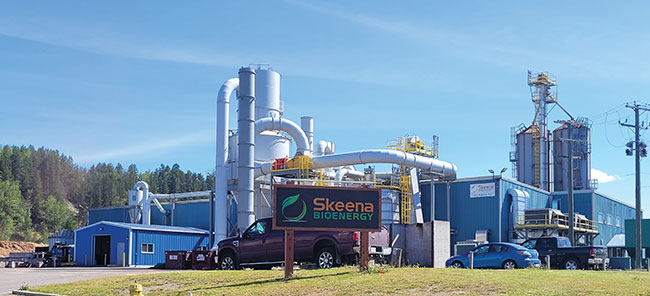
WPAC Report: Today’s wood pellets for tomorrow’s world
August 16, 2022
By Gordon Murray
WPAC executive director Gordon Murray explains how a resilient wood pellet sector can play a role in the growing bioeconomy.
 Skeena Bioenergy’s wood pellet plant in Terrace, B.C., is an important employer and an integral part of the local forest products industry, using sawmill residues as feedstock.
Photo by Nathan Bond, Skeena Bioenergy.
Skeena Bioenergy’s wood pellet plant in Terrace, B.C., is an important employer and an integral part of the local forest products industry, using sawmill residues as feedstock.
Photo by Nathan Bond, Skeena Bioenergy.
Despite the record global demand for wood pellets over the past two decades, biomass, particularly wood pellets, is in the infancy of its evolution. Both domestically and internationally, biomass’ potential in the transformation to a low-carbon, clean and renewable world is almost limitless.
Our vision at the Wood Pellet Association of Canada (WPAC) is two-fold. First, to grow a resilient pellet sector that creates green, renewable products at the forefront of the global transition to a low carbon economy, and second, to maximize the sector’s innovation in the bioeconomy.
In our recent video The Power of Pellets: Innovation in the Bioeconomy, Fahimeh Yazdan Panah, Ph.D., director of research and technical development at WPAC, explains that the bioeconomy is really the sustainable production of renewable resources and the conversion of these materials into higher value products such as food, bioenergy and bio-based materials.
“Wood pellets offer a world of possibilities not only to meet the targets of greenhouse gas emissions, but also to opening doors to having new and improved products. If you look around your home, everything that is made of plastic today could be made from wood and look exactly the same,” says Yazdan Panah.
Much of the bioenergy opportunities already realized by the Canadian wood pellet sector have been developed over the last decade, supported with nearly $1.6 million in public funding from Natural Resource Canada and Forestry Innovation Investment’s Expanding Market Opportunities program. This funding, directed through WPAC, enabled our sector to grow markets by 260 per cent and to generate $335 million in new sales, which has been invested in new plants, research, technology and people. In sum, we generated $211 for every taxpayer dollar spent to displace fossil fuels with responsible, renewable, clean energy in the form of wood pellets.
By creating a valuable energy product from material that once went to waste, Canadian wood pellet producers can take pride in providing global customers with responsible, low-carbon energy, yet this is really just the tip of the iceberg for the pellet sector.
Our sector has a significant role to play in the growing bioeconomy as well as alleviating energy poverty in places like Canada’s Maritimes and remote Indigenous communities, which are more dependent on fossil fuels.
Today, the wood pellet sector operates more than 50 pellet plants nationwide and is a major employer in many rural areas, providing Canadians with high paying jobs and strengthening local communities. The fact is that global markets also support expansion of domestic opportunities in Canada such as development of new bioproducts and reducing energy poverty.
Ironically, as our vessels depart Canadian ports destined for our export markets that use Canadian pellets to reduce GHG emissions, those vessels are passed by incoming ones to Canada loaded with coal and crude oil for domestic use.
Science shows that when you increase the demand for bioheat locally, you also contribute to better managed forests. In Sweden, bioenergy, largely in the form of wood, provides 37 per cent of the energy supply. Since 1990, Sweden’s bioenergy consumption has doubled and, at the same time, its standing timber volume has increased by 40 per cent. This increase in standing timber volume is not despite bioenergy, but because of it. With tens of millions of cubic metres of slash left in Canada’s forests every year, we can learn from this Swedish approach.
In Canada, the Williams Lake First Nation and the Tŝideldel First Nation are already at the forefront of this evolution. They have initiated several projects, with funding from the BC Forest Enhancement Society, to rehabilitate Douglas fir forests after a catastrophic wildfire, improve forest resiliency, and transport uneconomic residuals to support the Atlantic Power facility, which provides power to more than 50,000 homes in British Columbia. The future is here!
The fact is, to realize the full potential of wood pellets, it will take a strong commitment and stable support from government. WPAC looks forward to continuing to work with governments at all levels to realize those opportunities for the benefit of all Canadians and to support global efforts to tackle climate change.
I will give the last word to Gary Bull, Ph.D. forestry economics, professor and head of department for the University of British Columbia’s Department of Forest Resources Management who says, “wood pellets have an incredibly important role to play and we will see a huge evolution. The opportunities for using wood pellets right here at home and around the world are basically limitless.” •
Editor’s note: Join WPAC at their annual conference in Vancouver this September. Details here.
 Gordon Murray is the executive director of the Wood Pellet Association of Canada.
Gordon Murray is the executive director of the Wood Pellet Association of Canada.
Print this page